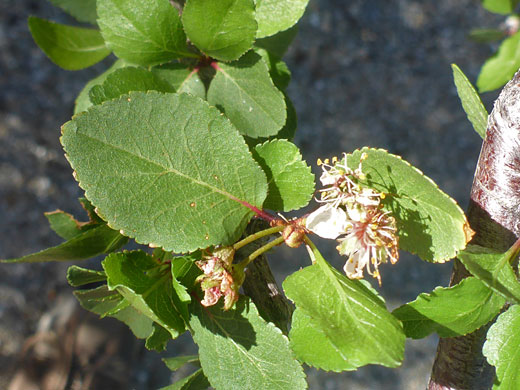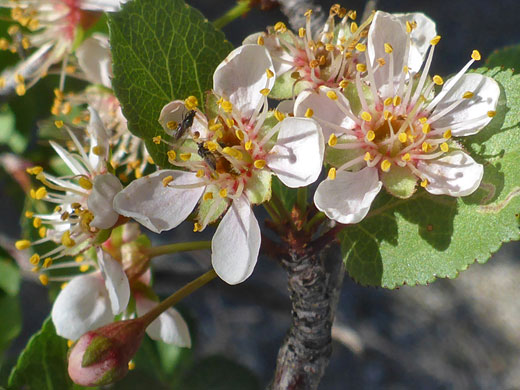Common name:
Desert apricot
Family:
Scientific name:
Prunus fremontii
Main flower color:
Range:
Far south California
Height:
Up to 12 feet
Habitat:
Canyons, rocky hillsides, pinyon-juniper woodland; up to 4,500 feet
Leaves:
Broadly ovate to round, up to 1.2 inches long, rounded at the base, lined by small, sharp teeth. On stalks of up to 0.3 inches
Season:
January to March
Prunus fremontii has limited distribution in southern California, mostly in and around Anza Borrego Desert State Park, along the west edge of the Sonoran Desert. Plants are shrubs, with thorny, woody branches and hairless, light green leaves, ovate to nearly round in outline; less than two times as long as wide.
Flowers are solitary or in groups of two or three, attached by hairless stalks of up to half an inch. The five sepals are light green, shallowly cupped, lined by tooth-like glands, and hairy underneath, while the five petals are a little longer (up to 0.4 inches), obovate, clawed, white to pale pink. Fruits are hairy, egg-shaped berries, green ageing to yellow. Flowers appear at the same time as the leaves, in early spring. The stamens, up to 25, have white filaments and yellow anthers.
Flowers are solitary or in groups of two or three, attached by hairless stalks of up to half an inch. The five sepals are light green, shallowly cupped, lined by tooth-like glands, and hairy underneath, while the five petals are a little longer (up to 0.4 inches), obovate, clawed, white to pale pink. Fruits are hairy, egg-shaped berries, green ageing to yellow. Flowers appear at the same time as the leaves, in early spring. The stamens, up to 25, have white filaments and yellow anthers.
All Contents © Copyright The American Southwest | Comments and Questions | Contribute | Site Map





